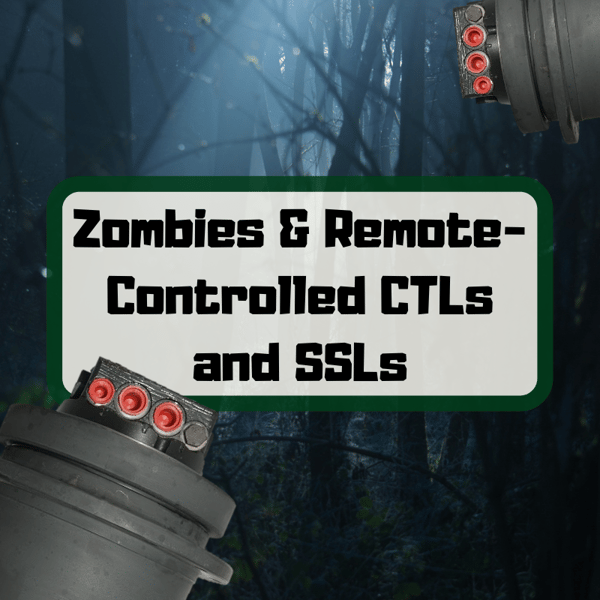One of the justifications for having a remote-controlled skid steer loader or track loader is the ability to perform dangerous tasks from a distance -- and that sounds like a good reason to have one on hand for a zombie apocalypse.

Here are some other Shop Talk Blog posts you might find interesting ...
- Built Robotics: Are Robots Going to Replace Operators?
- Update on the Built Robotics Self-Driving CTL
- Bobcat Final Drive Basics
- Rebuilding a Rexroth Caterpillar Final Drive Motor
Remote-Controlled Compact Machines
Situations that could be dangerous or uncomfortable to the operator -- like zombies! -- could warrant the use of a joystick-controlled CTL or SSL, and that might just be an area where a generation of video game enthusiasts could truly shine.
Where Remote-Controlled Compact Equipment Works Well
Real-world examples of situations that could warrant remote-controlled compact equipment include ...
- Loading/unloading cargo from ship holds
- Operating in a trench
- Grinding stumps or concrete
- Removal of spillage from beneath overhead conveyor belts
- Demolition applications
- Construction applications that work better with two people (e.g., asphalt planing, clearing out zombie remains from a road)
And some job sites are more dangerous than others, such as foundries, mines, nuclear plants, chemical plants, and perimeters around zombie-resistant shelters. The ability to remotely control your equipment could literally be a life-saver.
However, just because something can be done using remote-control doesn’t mean it should. Some tasks require an operator in the seat, using all available senses to perform delicate or precision work. And the biggest challenge, aside from getting used to the remote control system, is operating the skid steer or compact track loader when it is moving toward you. In such instances, the controls you execute would effectively be in reverse, because your right is the machine’s left.
Benefits of Remote-Controlled SSLs and CTLs
There’s a reason why companies like Bobcat and CAT have invested in developing remote-control capabilities for compact machines. Joystick-control provides three major benefits to operators:
- You can clearly see the machine as it maneuvers in its environment (i.e., not limited to a first-person view)
- You can clearly see the attachment (again, not limited to a first-person view)
- You can remain safe distance from the machine and the dangers surrounding it (including dust, falling debris, hungry zombies)
Safety Features of Remote-Controlled Compact Equipment
When unloading the hold of a ship or cleaning out beneath a conveyor, it is a good thing that the radio transmitter for the remote must remain in line of sight of the machine -- and if zombies are involved, that usually means you’re going to be up high. In addition, the machine must remain within the correct range (e.g., around 1,000 feet) for the remote control to work, which could be a problem if you have to be up too high.
If you are attacked by zombies during operation, remote-controlled systems made by CAT or Bobcat will interrupt the radio transmission (they can sense falls or trips) because it assumes you aren’t monitoring what the machine is doing anymore.
Conclusion
Since 2020 has been such an … interesting … year, it can’t hurt to plan ahead for a zombie outbreak. Having remote-controlled equipment could certainly be to your benefit, even if we never do encounter any zombies. And with all that said, don’t forget to keep your final drives maintained! The last thing you need to have happen is to see your faithful skid steer stalled out and surrounded by zombies because you didn't check the gear oil levels.


